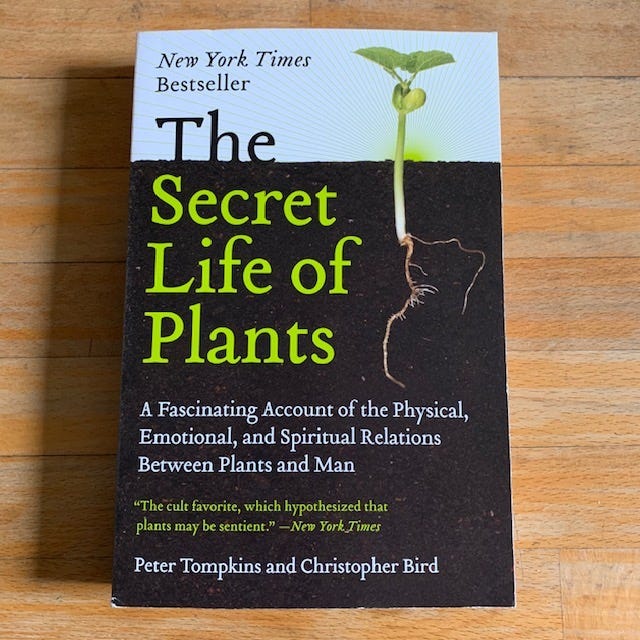
This is one of the least enjoyable books I’ve ever read. Ugh, so boring. Watching grass grow would have been better than this Sunday’s selection: ‘The Secret Life of Plants: A Fascinating Account of the Physical, Emotional, and Spiritual Relations Between Plants and Man’ by Peter Tompkins and Christopher Bird:

Don’t get me wrong, I love plants. We have several around our apartment (Donna even got our spider plant to bloom — a rare thing!). I enjoy being among them in Prospect Park. I visit botanic gardens sometimes. And I thought the performance of the plant in ‘The Professional’ was superb:

But this book didn’t do it for me, and this is the first time I’m reviewing a book I didn’t finish. I almost stopped 30 pages in because the book is ridiculous. (When Donna saw it was published in 1973, she said: ‘I wonder what psychedelic drugs these guys were on.’) I believe I pumped the brakes after the sentence where the authors equated scientists and Scientologists. But I figured it wasn’t fair to review a book after only a handful of pages, so I pressed on. Tompkins and Bird lean heavily on pseudo-science and conjecture for their evidence of plants’ ‘secret life,’ so it’s difficult to tell whether any of it is real or just New Age hucksterism. The book reminds me of a late-night History Channel show about how space aliens built the ancient pyramids. I mean, we learn about a guy who hooked his plant up to a polygraph machine, and from the squiggles it produced on a sheet of paper we’re supposed to believe that plants have ESP and can read minds? Sure. Seems legit. Scientists who can’t replicate the ESP experiments fail because the plant ‘fainted,’ or because they were not properly psychically synced to the plant. Right. Of course. Also, the writing stinks. The book goes on and on and on about electromagnetism and auras, and I don’t know what else because I started skimming and wasn’t paying attention. By the time I got to page 200, I had had enough. Life is too short, and I dreaded having to read more of this. I was Gary Oldman in ‘The Professional,’ like:

Maybe I just don’t like books about plants. I mean, I did trash ‘The Giving Tree’ back in the day. But there is one thing from ‘The Secret Life of Plants’ that I still think about a lot. It’s the sentence where, with complete seriousness, the authors mention ‘Russian development of animal guidance systems for training cats to pilot nonjammable air-to-air missiles’.
Just think about that for a second.
Cats.
Piloting missiles.
Like:

Plants add tranquility to our homes and shade to our streets. They sustain all life. They put up with all our pollution and construction and industry while remaining, as far as we can tell, indifferent. I’m sure they lead fascinating lives in their own way. They deserve a better book.
How it begins:
Short of Aphrodite, there is nothing lovelier on this planet than a flower, nor more essential than a plant. The true matrix of human life is the greensward covering mother earth. Without green plants we would neither breathe nor eat. On the undersurface of every leaf a million movable lips are engaged in devouring carbon dioxide and expelling oxygen. All together, 25 million square miles of leaf surface are daily engaged in this miracle of photosynthesis, producing oxygen and food for man and beast.
Of the 375 billion tons of food we consume each year the bulk comes from plants, which synthesize it out of air and soil with the help of sunlight. The remainder comes from animal products, which in turn are derived from plants. All the food, drink, intoxicants, drugs and medicines that keep man alive and, if properly used, radiantly healthy are ours through the sweetness of photosynthesis. Sugar produces all our starches, fats, oils, waxes, cellulose. From crib to coffin, man relies on cellulose as the basis for his shelter, clothing, fuel, fibers, basketry, cordage, musical instruments, and the paper on which he scribbles his philosophy. The abundance of plants profitably used by man is indicated by nearly six hundred pages in Uphof’s Dictionary of Economic Plants. Agriculture—as the economists agree—is the basis for a nation’s wealth.
Instinctively aware of the aesthetic vibrations of plants, which are spiritually satisfying, human beings are happiest and most comfortable when living with flora. At birth, marriage, death, blossoms are prerequisites, as they are at mealtime or festivities. We give plants and flowers as tokens of love, of friendship, or homage, and of thanks for hospitality. Our houses are adorned with gardens, our cities with parks, our nations with national preserves. The first thing a woman does to make a room livable is to place a plant in it or a vase of fresh cut flowers. Most men, if pressed, might describe paradise, whether in heaven or on earth, as a garden filled with luxuriant orchids, uncut, frequented by a nymph or two.
My rating:

‘The Secret Life of Plants: A Fascinating Account of the Physical, Emotional, and Spiritual Relations Between Plants and Man’ by Peter Tompkins and Christopher Bird was published in 1973 by HarperCollins Publishers. It was reprinted by Perennial Library in 2002. 402 pages, including index. $18 at Mast Books.

In two weeks you’ll get a review of ‘Sing, Unburied, Sing’ by Jesmyn Ward. Also in the queue are ‘Fleishman is in Trouble’ by Taffy Brodesser-Akner, ‘Disoriental’ by Négar Djavadi and ‘My Year of Rest and Relaxation’ by Ottessa Moshfegh, among others.
In case you missed it: Books on GIF #108 featured ‘The Autobiography of Gucci Mane’ by Gucci Mane.
Shoot me an email if there’s a bestseller, a classic or a forgotten gem you want reviewed.
Follow me on Twitter and Instagram.
Thanks for reading, and thanks especially to Donna for editing this review!
Until next time,

MPV



